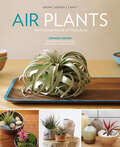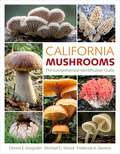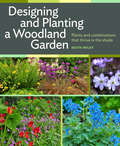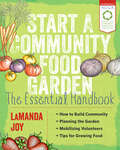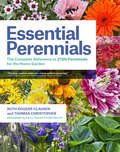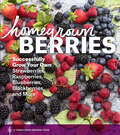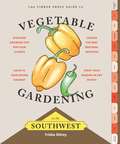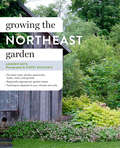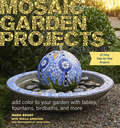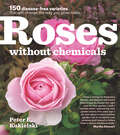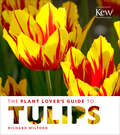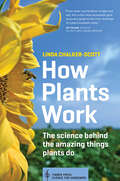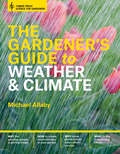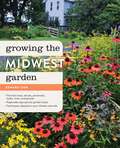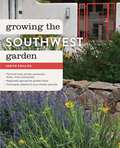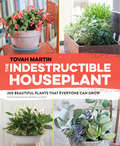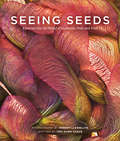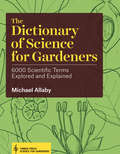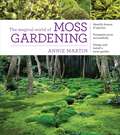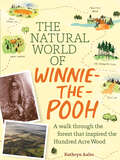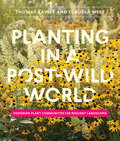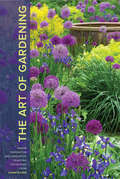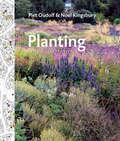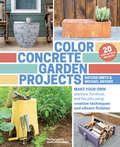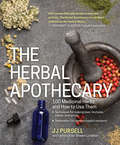- Table View
- List View
Air Plants: The Curious World of Tillandsias
by Zenaida Sengo Caitlin Atkinson“In this beautiful book, artist Zenaida Sengo has provided inspiration for designing and living with tillandsias.” —Flora GrubbAir Plants, by Zenaida Sengo shows how simple and rewarding it is to grow, craft, and design with these modern beauties. Decorating with air plants is made easy with stunning photographs that showcase ideas for using them mounted on walls, suspended from the ceiling, as living bows and jewelry, as screens, and in unique containers, like leather pouches, dishes, and baskets. Six step-by-step projects include a wood mount, a wall hook, lasso-and-hook wiring, a ceramic-frame garden, and three unique terrariums.
California Mushrooms: The Comprehensive Identification Guide
by Michael G. Wood Dennis E. Desjardin Frederick A. StevensWinner of the CBHL Award of Excellence California is one of the most ecologically rich and diverse regions of North America, and home to hundreds of species of mushrooms. In California Mushrooms, mycologist experts Dennis Desjardin, Michael Wood, and Fred Stevens provide over 1100 species profiles, including comprehensive descriptions and spectacular photographs. Each profile includes information on macro- and micromorphology, habitat, edibility, and comparisons with closely related species and potential look-alikes. Although the focus of the book is on mushrooms of California, over 90% of the species treated occur elsewhere, making the book useful throughout western North America. This complete reference covers everything necessary for the mushroom hunter to accurately identify over 650 species.
Designing and Planting a Woodland Garden: Plants and Combinations that Thrive in the Shade
by Keith WileyFrom the creator of "one of the most exciting and innovative gardens in Britain today" With their moss-covered stones, towering trees, and pockets of quiet shade, woodlands have a romantic power unlike anything else. Whether your garden is currently open and sunny, or on the small side, you can capture that sylvan atmosphere with carefully chosen trees and shade-loving plants. In Designing and Planting the Woodland Garden, Keith Wiley explains how to combine plants in natural, self-supporting colonies. His hand-picked selection of unexpected collectables—shrubs, perennials, bulbs, ferns, and grasses—mingle with garden favorites to create fabulous effects in all seasons.
Start a Community Food Garden: The Essential Handbook
by LaManda JoyRecommended by the American Community Gardening Association Community gardening enhances the fabric of towns and cities through social interactions and accessibility to fresh food, creating an enormously positive effect in the lives of everyone it touches. LaManda Joy, the founder of Chicago’s Peterson Garden Project and a board member of the American Community Gardening Association, has worked in the community gardening trenches for years and brings her knowledge to the wider world in Start a Community Food Garden. This hardworking guide covers every step of the process: fundraising, community organizing, site sourcing, garden design and planning, finding and managing volunteers, and managing the garden through all four seasons. A section dedicated to the basics of growing was designed to be used by community garden leaders as an educational tool for teaching new members how to successfully garden.
Essential Perennials: The Complete Reference to 2700 Perennials for the Home Garden
by Alan L. Detrick Thomas Christopher Ruth Rogers ClausenEssential Perennials focuses on what every gardener needs to know to choose from the thousands of perennials available, and care for the ones you already have. This A-to-Z guide is packed with more than 2,700 plants, with each entry listing flower color, bloom time, foliage characteristics, size, and light and temperature requirements. Each profile is supported by stunning color photography that showcases the flower and foliage that make each plant unique.
Homegrown Berries: Successfully Grow Your Own Strawberries, Raspberries, Blueberries, Blackberries, and More
by Timber PressEnjoy delicious, nutritious berries from your own backyard! What says summer more than a bowl full of fresh berries? How about a yard full of them? Homegrown Berries covers the information you need to know about the process from planting to picking. You’ll learn the best varieties of strawberries, raspberries, blackberries, blueberries, gooseberries, currants, and elderberries for you, how to fit them into your landscape (including in borders and containers), and how to maintain them for peak harvest. Summer just got sweeter!
Timber Press Guide to Vegetable Gardening in the Southwest (Regional Vegetable Gardening Series)
by Trisha ShireyThere is nothing more regionally specific than vegetable gardening—what to plant, when to plant it, and when to harvest are decisions based on climate, weather, and first frost. The Timber Press Guide to Vegetable Gardening in the Southwest, by regional expert Trisha Shirey, focuses on the unique eccentricities of the Southwest gardening calendar, which include extreme temperatures and low rainfall. The month-by-month format makes it perfect for beginners and accessible to everyone— gardeners can start gardening the month they pick it up. Perfect for home gardeners in Arizona, Nevada, New Mexico, Oklahoma, Texas, Utah, eastern California, and southern Colorado.
Growing the Northeast Garden: Regional Ornamental Gardening (Regional Ornamental Gardening Series)
by Andrew Keys Kerry MichaelsPlant selection and garden style are deeply influenced by where we are gardening. To successfully grow a range of beautiful ornamental plants, every gardener has to know the specifics of the region’s climate, soil, and geography. Gardeners in the northeast are lucky—the regular summer rain, gorgeous summer blooms, and stunning fall color make it an ideal place to garden. But there are drawbacks, like hot and humid summers, bitterly cold winters, and mosquitos. TThe practical and beautiful Growing the Northeast Garden starts with a comprehensive overview of the weather and geography of the area, along with regionally specific advice on zones, microclimates, soil, pests, and maintenance. Profiles of the best trees, shrubs, perennials, annuals, and bulbs offer hundreds of plant suggestions, along with complete information on growth and care.
Mosaic Garden Projects: Add Color to Your Garden with Tables, Fountains, Bird Baths, and More
by Mark Brody Sheila Ashdown“This thorough guide to techniques, tools, and materials is filled with expert tips and tricks. The detailed project instructions will inspire you to make your own mosaicked mark on the landscape.” —Lorene Edwards Forkner, author of Handmade Garden Projects In Mosaic Garden Projects, artist Mark Brody walks step-by-step through the creation of 25 decorative yet functional projects. With simple ideas like address signs and stepping stones to more complex projects such as an orb fountain, Brody also includes with a primer on the fundamentals of mosaic and information on the range of possible materials. Project templates are included along with instructions on how to scale each project. Mosaic Garden Projects is packed with inspiration that will brighten the garden all year long.
Roses Without Chemicals: 150 Disease-Free Varieties That Will Change the Way You Grow Roses
by Peter Kukielski“I wish I had this when I planted my rose garden twenty-five years ago. I am now about to plant another garden, full of wonderful rose varieties and I intend to follow Peter's advice wholeheartedly.” —Martha Stewart Have you tried to grow roses, only to give up once you realized how dependent on pesticides they are? In this lush guide rose expert Peter Kukielski highlights 150 rose varieties that excel in gardens without the use of chemicals. Roses Without Chemicals features information on planting, pruning, and pests; plant profiles that include a color photo and details on color, growth habit, and fragrance; and helpful lists of roses organized by color, growing habit, and region.
The Plant Lover's Guide to Tulips (The Plant Lover’s Guides)
by Richard WilfordTulips are one of the most popular spring-flowering bulbs. Available in a huge range of colors and in a wide array of shapes, they’re a mainstay of most spring gardens. They are the focus of festivals worldwide and are a sure sign spring is on the way. The Plant Lover’s Guide to Tulips, by Richard Wilford of the Royal Botanic Gardens Kew, profiles 100 commonly available species and cultivars, and features growing information, recommendations for companion plants, and tips on how to use tulips in the landscape. More than 250 color photographs bring these colorful gems to life.
How Plants Work: The Science Behind the Amazing Things Plants Do (Science For Gardeners Ser.)
by Linda Chalker-ScottThe more you know, the better you grow! Plants are capable of interesting and unexpected things. Why do container plants wilt when they’ve been regularly watered? Why did the hydrangea that thrived last year never bloom this year? Why do slugs wipe out the vegetable garden instead of eating the weeds? Plant physiology—the study of how living things function—can solve these and most other problems gardeners regularly encounter.In How Plants Work, horticulture expert and contributor to the popular blog The Garden Professors, Linda Chalker-Scott brings the stranger-than-fiction science of the plant world to vivid life. She uncovers the mysteries of how and why plants do the things they do, and arms the home gardener with fascinating knowledge that will change the way they garden.
The Gardener's Guide to Weather and Climate: How to Understand the Weather and Make It Work for You (Science For Gardeners Ser.)
by Michael Allaby“We owe it to our plants to read this book. After all, while we just live with the weather, our plants have to survive it.” —The Washington Post All gardeners are at the whim of Mother Nature, and so are our plants. Whether it’s coping with extreme drought or record-breaking snow fall, gardeners—and gardens—across the country are fighting against the elements. Instead of just reacting to the weather, Michael Allaby suggests that gardeners use knowledge about how the weather works to create the best growing conditions for their plants. Allaby brings big-picture atmospheric concepts to life with a comprehensive introduction to how weather works and explanations climate change, weather systems, and microclimates. The Gardener’s Guide to Weather and Climate proves that instead of gardening at the mercy of the weather, knowledgeable gardeners can make the weather work for them
Growing the Midwest Garden: Regional Ornamental Gardening (Regional Ornamental Gardening Series)
by Edward LyonPart of the Timber Press Regional Ornamental Gardening book series, this book is ideal for home gardeners in Illinois, Indiana, Iowa, Kansas, Michigan, Minnesota, Missouri, Nebraska, North Dakota, Ohio, South Dakota, Wisconsin, southern Ontario, southern Manitoba, and southeastern Saskatchewan.
Growing the Southwest Garden: Regional Ornamental Gardening (Regional Ornamental Gardening Series)
by Judith PhillipsPlant selection and garden style are deeply influenced by where we are gardening. To successfully grow a range of beautiful ornamental plants, every gardener has to know the specifics of the region’s climate, soil, and geography.Growing the Southwest Garden, by New Mexico-based garden designer Judith Phillips, is a practical and beautiful handbook for ornamental gardening in a region known for its low rainfall and high temperatures. With more than thirty years of experience gardening in the Southwest, Phillips has created an essential guide, featuring regionally specific advice on zones, microclimates, soil, pests, and maintenance. Profiles of the best plants for the region include complete information on growth and care.
The Indestructible Houseplant: 200 Beautiful Plants that Everyone Can Grow
by Tovah MartinThe Indestructible Houseplant, by garden writer Tovah Martin, eliminates the guesswork by highlighting indoor plants that are tough, beautiful, reliable, and readily available. Like hoya, a low-maintenance plant whose spectacular spring and summer blossoms actually thrive on neglect. Or Ficus elastica (also known as rubber tree), whose pink and gray leaves will brighten even the most challenging windowless environment. And castiron plant, an old favorite that remains beautiful in a shady corner, even after weeks without water. In addition to plant profiles with concise information on water, light, and blooming times, this gorgeous book includes tips on care, maintenance, and ideas for combining houseplants in eye-catching indoor displays.
Seeing Seeds: A Journey into the World of Seedheads, Pods, and Fruit (Seeing Series)
by Robert Llewellyn Teri Dunn Chace“Llewellyn’s images reflect a depth of detail that until now, only the best botanical illustrators could approach.” —The Washington Post A centuries-old saying goes, “Great oaks from little acorns grow.” But as this dazzling book reveals, there is much more to a seed than the plant it will someday become: seeds, seedheads, pods, and fruits have their own astounding beauty that rivals, and sometimes even surpasses, the beauty of flowers. Bitter melon seeds resemble a handful of rubies. Poppy pods could be art nouveau salt shakers. And butterfly vine seeds look exactly like those delicate insects captured in mid-flight. Seeds also come with fascinating stories. Jewels of Opar got its name from a fabled city in Edgar Rice Burroughs’s Tarzan stories. Lotus seeds sent into orbit by Chinese scientists came back to earth mysteriously altered. And fava beans—beloved of foodies—have a Jekyll-and-Hyde personality: they can cause the debilitating condition known as favism in some individuals and at the same time combat the microorganism that causes malaria. In these stunning pages you’ll gain an understanding of how seeds are formed and dispersed, why they look the way they do, and how they fit into the environment. Seeing Seeds will take you to strange and wonderful places. When you return, it’s safe to say that you’ll never look at a seed the same way again.
The Dictionary of Science for Gardeners: 6000 Scientific Terms Explored and Explained (Science For Gardeners Ser.)
by Michael AllabyA Library Journal Best Reference Pick of 2015! Every gardener is a scientist. Pollination, native plants, ecology, climatology—these are just a few of the scientific concepts that play a key role in a successful garden. While the ideas are intuitive to many gardeners, they are often discussed in unfamiliar scientific terms. The Dictionary of Science for Gardeners is the first of its kind to provide practical scientific descriptions for gardening terms. Highlighting 16 branches of science that are of particular interest to gardeners, with entries from abaptation to zoochory, Michael Allaby explores more than 6,000 terms in one easy-to-use reference.
The Magical World of Moss Gardening
by Annie Martin“This is a fascinating books for anyone wanting to truly broaden the range of plants they grow.” —Gardens Illustrated Moss is an extraordinary plant—it grows without roots, flowers, or stems. Despite being overlooked, in many ways, moss is perfect: it provides year-round color, excels in difficult climates, prevents soil erosion, and resists pests and disease. In The Magical World of Moss Gardening, bryophyte expert Annie Martin reveals how moss can be used in stunning, eco-friendly spaces. The beautifully illustrated guide includes basics on designing and planting a moss garden, as an inspiring tour of the most magical public and private moss gardens throughout the country.
The Natural World of Winnie-the-Pooh: A Walk Through the Forest that Inspired the Hundred Acre Wood
by Kathryn AaltoLoved “Goodbye Christopher Robin”? Learn more about the real place that inspired the beloved stories. Delve into the home of the world’s most beloved bear! The Natural World of Winnie-the-Pooh explores the magical landscapes where Pooh, Christopher Robin, and their friends live and play. The Hundred Acre Wood—the setting for Winnie-the-Pooh’s adventures—was inspired by Ashdown Forest, a wildlife haven that spans more than 6,000 acres in southeast England. In the pages of this enchanting book you can visit the ancient black walnut tree on the edge of the forest that became Pooh’s house, go deep into the pine trees to find Poohsticks Bridge, and climb up to the top of the enchanted Galleons Lap, where Pooh says goodbye to Christopher Robin. You will discover how Milne's childhood connection with nature and his role as a father influenced his famous stories, and how his close collaboration with illustrator E. H. Shepard brought those stories to life. This charming book also serves as a guide to the plants, animals, and places of the remarkable Ashdown Forest, whether you are visiting in person or from the comfort of your favorite armchair. In a delightful narrative, enriched with Shepard’s original illustrations, hundreds of color photographs, and Milne’s own words, you will rediscover your favorite characters and the magical place they called home.
Planting in a Post-Wild World: Designing Plant Communities for Resilient Landscapes
by Thomas Rainer Claudia West“As practical as it is poetic. . . . an optimistic call to action.” —Chicago Tribune Over time, with industrialization and urban sprawl, we have driven nature out of our neighborhoods and cities. But we can invite it back by designing landscapes that look and function more like they do in the wild: robust, diverse, and visually harmonious. Planting in a Post-Wild World by Thomas Rainer and Claudia West is an inspiring call to action dedicated to the idea of a new nature—a hybrid of both the wild and the cultivated—that can flourish in our cities and suburbs. This is both a post-wild manifesto and practical guide that describes how to incorporate and layer plants into plant communities to create an environment that is reflective of natural systems and thrives within our built world.
The Art of Gardening: Design Inspiration and Innovative Planting Techniques from Chanticleer
by R. William Thomas“Delightful!” —The New York Times Book Review Discover a world of beauty and creativity! Chanticleer has been called the most romantic, imaginative, and exciting public garden in America. It is a place of pleasure and learning, relaxing yet filled with ideas to take home. And now those lessons are available for everyone in this stunning book! You’ll learn techniques specific to different conditions and plant palettes; how to use hardscape materials in a fresh way; and how to achieve the perfect union between plant and site. And Rob Cardillo’s exquisite photographs of exciting combinations will be sure to stimulate your own creativity. Whether you’re already under Chanticleer’s spell or have yet to visit, The Art of Gardening will enable you to bring the special magic that pervades this most artful of gardens into your own home landscape.
Planting: A New Perspective
by Noel Kingsbury Piet OudolfPlanting: A New Perspective is an essential resource for designers and gardeners looking to create plant-rich, beautiful gardens that support biodiversity and nourish the human spirit. An intimate knowledge of plants is essential to the success of modern landscape design, and Planting makes Oudolf’s considerable understanding of plant ecology and performance accessible, explaining how plants behave in different situations, what goes on underground, and which species make good neighbors. Extensive plant charts and planting plans will help you choose plants for their structure, color, and texture as well as the way they perform in the landscape. A detailed directory with details like each plant’s life expectancy, the persistence of its seedheads, its tendency to spread, and propensity to self-seed, this book is a beautiful and invaluable resource.
Color Concrete Garden Projects: Make Your Own Planters, Furniture, and Fire Pits Using Creative Techniques and Vibrant Finishes
by Michael Snyder Nathan Smith Charles ColemanA Library Journal Best Crafts & DIY Book of 2015 Incorporating concrete design into a home garden can now be easily achieved by any do-it-yourself enthusiast! Concrete furniture and containers add style and personality to outdoor spaces, and the addition of color makes these objects even more eye-catching. These trendy pieces can cost thousands of dollars at garden centers and furniture stores, but they can also be made affordably at home. In this hands-on guide, concrete artisans Nathan Smith and Michael Snyder offer basic information on how to mix concrete and add color using dyes, paints, and inlaid materials. The twenty step-by-step projects include small items, like a candle holder with an old-world feel and a simple stacked-ring planter, and larger pieces, like an elegant bike rack and a beautiful fire pit that is the perfect gathering place for friends and family.
The Herbal Apothecary: 100 Medicinal Herbs and How to Use Them
by Jj Pursell“A brilliant addition to any library.” —Rosemary Gladstar, herbalist and bestselling author More and more people are exploring the healing possibilities of plant-based medicines, and health shops across the country now stock their shelves with natural remedies, but treatments can easily be made at home. The Herbal Apothecary profiles 100 of the most important medicinal plants with striking photographs and step-by-step instructions for making herbal teas, tinctures, compresses, and salves to treat everything from muscle strain to the common cold or anxiety. This holistic guide also includes advice for the home gardener on growing and foraging for medicinal plants. Incorporating traditional wisdom and scientific information, The Herbal Apothecary provides an accessible and comprehensive introduction to plant-based medicine. With the guidance of naturopath JJ Pursell, herb enthusiasts can learn how to safely create their own remedies using plants they know and love.
